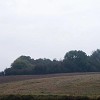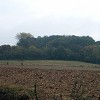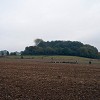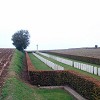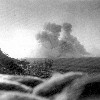Hawthorn Ridge Redoubt
Hawthorn Ridge Redoubt was a German front-line fortification west of the village of Beaumont Hamel on the Somme. It was the scene of a number of costly attacks by British infantry during the Battle of the Somme in 1916. It was also the site of one of the most famous pieces of film footage of World War I when the Hawthorn Ridge mine was detonated beneath the redoubt at 7:20 am on 1 July 1916, the first day on the Somme. The Hawthorn Ridge mine was the northern-most of the ten mines dug by the Royal Engineer tunnelling companies. It was detonated on July 1, one of the three large mines, the other two being the Lochnagar mine and the Y Sap mine at La Boisselle. The mine contained about 40,000 pounds (18 t) of explosives. The plan was to detonate all other mines at 7:28 am, two minutes before Zero hour when the infantry advance would begin, but Lieutenant-General Aylmer Hunter-Weston, whose VIII Corps was holding the Hawthorn Ridge sector, favoured blowing the mine hours before the main attack, believing this would give his 29th Division time to capture and consolidate the crater. However, the Fourth Army commander, Lieutenant-General Henry Rawlinson rejected this proposal on the grounds that the Germans would probably take possession of the crater. In this stance he was supported by General Sir Douglas Haig, commander of the British Expeditionary Force. As a compromise, Hunter-Weston was allowed to blow the mine ten minutes before Zero, rather than two minutes. Once the debris subsided, two platoons of the 2nd Battalion, Royal Fusiliers (86th Brigade, 29th Division) were sent forward to occupy the crater. However, the German defenders succeeded in holding the eastern lip of the crater. The early detonation alerted all Germans in the vicinity that the long-expected attack was now imminent. By the time the infantry went over at 7:30 am, the German machine guns were sweeping no man's land and artillery fire was falling on the British trenches. The attack on Hawthorn Ridge redoubt, and on the entire VIII Corps front, ended in failure. By 8:30 am, the only "gain" by the 29th Division was one company clinging to the western lip of the crater but by the end of the day this too was lost. After the disaster of the first day on the Somme, British efforts were concentrated south of the Albert-Bapaume road and the Hawthorn Ridge sector was not subjected to further major attacks until the final push of the battle on 13 November with the opening of the Battle of the Ancre. For this attack another mine was laid beneath Hawthorn Ridge, this time containing 30,000 lb (13 tons) of explosives. On this occasion, superior British planning resulted in a successful assault and Hawthorn Ridge as well as Beaumont Hamel were finally captured.








